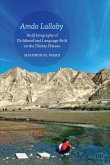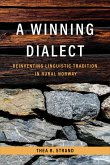- Broschiertes Buch
- Merkliste
- Auf die Merkliste
- Bewerten Bewerten
- Teilen
- Produkt teilen
- Produkterinnerung
- Produkterinnerung
Keep Talking, a comprehensive, contemporary introduction to the field of linguistic anthropology, highlights the work of Canadian scholars and offers students everywhere a new lens for understanding the relationship between language and culture.
Andere Kunden interessierten sich auch für
![Sightlines Sightlines]() Eileen KaneSightlines32,99 €
Eileen KaneSightlines32,99 €![Freedoms of Speech Freedoms of Speech]() Matea CandeaFreedoms of Speech47,99 €
Matea CandeaFreedoms of Speech47,99 €![Moving Words Moving Words]() Andrew BrandelMoving Words33,99 €
Andrew BrandelMoving Words33,99 €![Sing Me Back Home Sing Me Back Home]() Kristina JacobsenSing Me Back Home33,99 €
Kristina JacobsenSing Me Back Home33,99 €![Amdo Lullaby Amdo Lullaby]() Shannon WardAmdo Lullaby28,99 €
Shannon WardAmdo Lullaby28,99 €![A Winning Dialect A Winning Dialect]() Thea R. StrandA Winning Dialect30,99 €
Thea R. StrandA Winning Dialect30,99 €![Empanadas, Pupusas, and Greens on the Side Empanadas, Pupusas, and Greens on the Side]() Amelia TsengEmpanadas, Pupusas, and Greens on the Side27,99 €
Amelia TsengEmpanadas, Pupusas, and Greens on the Side27,99 €-
-
-
Keep Talking, a comprehensive, contemporary introduction to the field of linguistic anthropology, highlights the work of Canadian scholars and offers students everywhere a new lens for understanding the relationship between language and culture.
Produktdetails
- Produktdetails
- Verlag: University of Toronto Press
- Seitenzahl: 296
- Erscheinungstermin: 30. November 2025
- Englisch
- Abmessung: 229mm x 152mm x 25mm
- Gewicht: 628g
- ISBN-13: 9781487563714
- ISBN-10: 148756371X
- Artikelnr.: 73930921
- Herstellerkennzeichnung
- Libri GmbH
- Europaallee 1
- 36244 Bad Hersfeld
- gpsr@libri.de
- Verlag: University of Toronto Press
- Seitenzahl: 296
- Erscheinungstermin: 30. November 2025
- Englisch
- Abmessung: 229mm x 152mm x 25mm
- Gewicht: 628g
- ISBN-13: 9781487563714
- ISBN-10: 148756371X
- Artikelnr.: 73930921
- Herstellerkennzeichnung
- Libri GmbH
- Europaallee 1
- 36244 Bad Hersfeld
- gpsr@libri.de
Eric S. Henry is an associate professor of anthropology at Saint Mary’s University.
Foreword
Part 1: Talking About Talk: Key Terms and Concepts
1. Anthropology
1.1 The Culture Concept
2. Linguistics
2.1 Ferdinand de Saussure
2.2 Noam Chomsky
2.3 Levels of Linguistic Structure
3. An Anthropology of Language
3.1 Speech Community
3.2 Language Ideology
3.3 Indexicality
4. Conclusion
Part 2: What Is Language?
5. Animal Communication
6. Human Language
7. Discourse
7.1 Talking Like a Human
7.2 Sign Languages in Nicaragua
8. Conclusion
Part 3: Language Socialization
9. Two Language Socialization Stories
10. Social Orientation: From Language to Culture
10.1 Language Ideology
10.2 Space
10.3 Gender
11. Ongoing Socialization: “Not Just Kid Stuff”
11.1 Baristas
11.2 Bureaucrats
11.3 Lawyers
12. Conclusion
Part 4: Linguistic Relativity
13. The Sapir-Whorf Hypothesis
13.1 Classifying the World
13.2 Evaluating the Sapir-Whorf Hypothesis
14. Linguistic Relativity
14.1 Metaphor
14.2 Context
15. Conclusion
Part 5: Indigenous Languages and Revitalization
16. Walking with Indigenous Languages
16.1 Polysynthesis
16.2 Evidentiality
16.3 Land and Place-Making
17. Language Endangerment
18. Language Revitalization
18.1 Emergent Vitalities
19. Conclusion
Part 6: Social Identity and Performativity
20. Performativity
21. Social Identity
22. Enregisterment
23. Connecting Language and Identity Together
24. Conclusion
Part 7: Language and Gender
25. From Women’s Language to Gendered Language
25.1 Gendered Communication in Cross-Cultural Perspective
25.2 The Problem of Women’s Voices
26. Language and Masculinity
27. Conclusion
Part 8: Raciolinguistics
28. What is Race?
28.1 Racialization and Ethnicization
29. African-American Vernacular English
30. Covert Racist Discourse
31. Encounters Across Race and Language
32. Conclusion
Part 9: Multilingualism and Globalization
33. Colonialism and Standardization
34. Multilingual Societies
34.1 Canada: A Case Study in Multilingualism
34.2 Diglossia
34.3 Pidgins and Creoles
35. Mixing Languages Together
36. Conclusion
Part 10: Orality and Literacy
37. Spoken and Written Texts
38. Orality and Verbal Art
38.1 Performance
39. Literacy
39.1 Literacy and Power
39.2 Multiliteracies
40. Conclusion
Part 11: Digital Language
41. New Communication Technologies
42. Interdiscursivity
43. Texting LOL!
44. Conclusion
Part 12: Researching Language in Society
45. Ethics
46. Interviewing: Learning How to Ask, Learning How to Listen
47. Linguistic Landscape
48. Dialect Surveys
49. Conclusion
References
Part 1: Talking About Talk: Key Terms and Concepts
1. Anthropology
1.1 The Culture Concept
2. Linguistics
2.1 Ferdinand de Saussure
2.2 Noam Chomsky
2.3 Levels of Linguistic Structure
3. An Anthropology of Language
3.1 Speech Community
3.2 Language Ideology
3.3 Indexicality
4. Conclusion
Part 2: What Is Language?
5. Animal Communication
6. Human Language
7. Discourse
7.1 Talking Like a Human
7.2 Sign Languages in Nicaragua
8. Conclusion
Part 3: Language Socialization
9. Two Language Socialization Stories
10. Social Orientation: From Language to Culture
10.1 Language Ideology
10.2 Space
10.3 Gender
11. Ongoing Socialization: “Not Just Kid Stuff”
11.1 Baristas
11.2 Bureaucrats
11.3 Lawyers
12. Conclusion
Part 4: Linguistic Relativity
13. The Sapir-Whorf Hypothesis
13.1 Classifying the World
13.2 Evaluating the Sapir-Whorf Hypothesis
14. Linguistic Relativity
14.1 Metaphor
14.2 Context
15. Conclusion
Part 5: Indigenous Languages and Revitalization
16. Walking with Indigenous Languages
16.1 Polysynthesis
16.2 Evidentiality
16.3 Land and Place-Making
17. Language Endangerment
18. Language Revitalization
18.1 Emergent Vitalities
19. Conclusion
Part 6: Social Identity and Performativity
20. Performativity
21. Social Identity
22. Enregisterment
23. Connecting Language and Identity Together
24. Conclusion
Part 7: Language and Gender
25. From Women’s Language to Gendered Language
25.1 Gendered Communication in Cross-Cultural Perspective
25.2 The Problem of Women’s Voices
26. Language and Masculinity
27. Conclusion
Part 8: Raciolinguistics
28. What is Race?
28.1 Racialization and Ethnicization
29. African-American Vernacular English
30. Covert Racist Discourse
31. Encounters Across Race and Language
32. Conclusion
Part 9: Multilingualism and Globalization
33. Colonialism and Standardization
34. Multilingual Societies
34.1 Canada: A Case Study in Multilingualism
34.2 Diglossia
34.3 Pidgins and Creoles
35. Mixing Languages Together
36. Conclusion
Part 10: Orality and Literacy
37. Spoken and Written Texts
38. Orality and Verbal Art
38.1 Performance
39. Literacy
39.1 Literacy and Power
39.2 Multiliteracies
40. Conclusion
Part 11: Digital Language
41. New Communication Technologies
42. Interdiscursivity
43. Texting LOL!
44. Conclusion
Part 12: Researching Language in Society
45. Ethics
46. Interviewing: Learning How to Ask, Learning How to Listen
47. Linguistic Landscape
48. Dialect Surveys
49. Conclusion
References
Foreword
Part 1: Talking About Talk: Key Terms and Concepts
1. Anthropology
1.1 The Culture Concept
2. Linguistics
2.1 Ferdinand de Saussure
2.2 Noam Chomsky
2.3 Levels of Linguistic Structure
3. An Anthropology of Language
3.1 Speech Community
3.2 Language Ideology
3.3 Indexicality
4. Conclusion
Part 2: What Is Language?
5. Animal Communication
6. Human Language
7. Discourse
7.1 Talking Like a Human
7.2 Sign Languages in Nicaragua
8. Conclusion
Part 3: Language Socialization
9. Two Language Socialization Stories
10. Social Orientation: From Language to Culture
10.1 Language Ideology
10.2 Space
10.3 Gender
11. Ongoing Socialization: “Not Just Kid Stuff”
11.1 Baristas
11.2 Bureaucrats
11.3 Lawyers
12. Conclusion
Part 4: Linguistic Relativity
13. The Sapir-Whorf Hypothesis
13.1 Classifying the World
13.2 Evaluating the Sapir-Whorf Hypothesis
14. Linguistic Relativity
14.1 Metaphor
14.2 Context
15. Conclusion
Part 5: Indigenous Languages and Revitalization
16. Walking with Indigenous Languages
16.1 Polysynthesis
16.2 Evidentiality
16.3 Land and Place-Making
17. Language Endangerment
18. Language Revitalization
18.1 Emergent Vitalities
19. Conclusion
Part 6: Social Identity and Performativity
20. Performativity
21. Social Identity
22. Enregisterment
23. Connecting Language and Identity Together
24. Conclusion
Part 7: Language and Gender
25. From Women’s Language to Gendered Language
25.1 Gendered Communication in Cross-Cultural Perspective
25.2 The Problem of Women’s Voices
26. Language and Masculinity
27. Conclusion
Part 8: Raciolinguistics
28. What is Race?
28.1 Racialization and Ethnicization
29. African-American Vernacular English
30. Covert Racist Discourse
31. Encounters Across Race and Language
32. Conclusion
Part 9: Multilingualism and Globalization
33. Colonialism and Standardization
34. Multilingual Societies
34.1 Canada: A Case Study in Multilingualism
34.2 Diglossia
34.3 Pidgins and Creoles
35. Mixing Languages Together
36. Conclusion
Part 10: Orality and Literacy
37. Spoken and Written Texts
38. Orality and Verbal Art
38.1 Performance
39. Literacy
39.1 Literacy and Power
39.2 Multiliteracies
40. Conclusion
Part 11: Digital Language
41. New Communication Technologies
42. Interdiscursivity
43. Texting LOL!
44. Conclusion
Part 12: Researching Language in Society
45. Ethics
46. Interviewing: Learning How to Ask, Learning How to Listen
47. Linguistic Landscape
48. Dialect Surveys
49. Conclusion
References
Part 1: Talking About Talk: Key Terms and Concepts
1. Anthropology
1.1 The Culture Concept
2. Linguistics
2.1 Ferdinand de Saussure
2.2 Noam Chomsky
2.3 Levels of Linguistic Structure
3. An Anthropology of Language
3.1 Speech Community
3.2 Language Ideology
3.3 Indexicality
4. Conclusion
Part 2: What Is Language?
5. Animal Communication
6. Human Language
7. Discourse
7.1 Talking Like a Human
7.2 Sign Languages in Nicaragua
8. Conclusion
Part 3: Language Socialization
9. Two Language Socialization Stories
10. Social Orientation: From Language to Culture
10.1 Language Ideology
10.2 Space
10.3 Gender
11. Ongoing Socialization: “Not Just Kid Stuff”
11.1 Baristas
11.2 Bureaucrats
11.3 Lawyers
12. Conclusion
Part 4: Linguistic Relativity
13. The Sapir-Whorf Hypothesis
13.1 Classifying the World
13.2 Evaluating the Sapir-Whorf Hypothesis
14. Linguistic Relativity
14.1 Metaphor
14.2 Context
15. Conclusion
Part 5: Indigenous Languages and Revitalization
16. Walking with Indigenous Languages
16.1 Polysynthesis
16.2 Evidentiality
16.3 Land and Place-Making
17. Language Endangerment
18. Language Revitalization
18.1 Emergent Vitalities
19. Conclusion
Part 6: Social Identity and Performativity
20. Performativity
21. Social Identity
22. Enregisterment
23. Connecting Language and Identity Together
24. Conclusion
Part 7: Language and Gender
25. From Women’s Language to Gendered Language
25.1 Gendered Communication in Cross-Cultural Perspective
25.2 The Problem of Women’s Voices
26. Language and Masculinity
27. Conclusion
Part 8: Raciolinguistics
28. What is Race?
28.1 Racialization and Ethnicization
29. African-American Vernacular English
30. Covert Racist Discourse
31. Encounters Across Race and Language
32. Conclusion
Part 9: Multilingualism and Globalization
33. Colonialism and Standardization
34. Multilingual Societies
34.1 Canada: A Case Study in Multilingualism
34.2 Diglossia
34.3 Pidgins and Creoles
35. Mixing Languages Together
36. Conclusion
Part 10: Orality and Literacy
37. Spoken and Written Texts
38. Orality and Verbal Art
38.1 Performance
39. Literacy
39.1 Literacy and Power
39.2 Multiliteracies
40. Conclusion
Part 11: Digital Language
41. New Communication Technologies
42. Interdiscursivity
43. Texting LOL!
44. Conclusion
Part 12: Researching Language in Society
45. Ethics
46. Interviewing: Learning How to Ask, Learning How to Listen
47. Linguistic Landscape
48. Dialect Surveys
49. Conclusion
References








